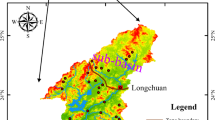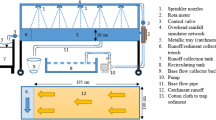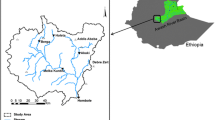Abstract
The Soil Conservation Service Curve Number (SCS-CN) method is frequently used for the estimation of direct surface runoff depth from the small watersheds. Coupling the SCS-CN method with the Soil Moisture Balance (SMB) method, new simple 2-parameters rainfall-runoff model and 3-parametrs rainfall-sediment yield models are derived for computation of runoff and sediment yield respectively. The proposed runoff (R2) and sediment yield (S2) models have been tested on a large set of rainfall-runoff and sediment yield data (98 storm events) obtained from twelve watersheds from different land use/land cover, soil and climatic conditions. The improved runoff (R2) and sediment yield (S2) models show superior results as compared to the existing Mishra et al. (S1) and original SCS-CN (R1) models. The results and analysis justify the use of the proposed models for field applications.





Similar content being viewed by others
References
Agriculture Department (Soil Conservation Section) (1990) Project on hydrological and sedimentation monitoring - Mansara watershed, flood prone river Gomati, unpub. Govt. of Uttar Pradesh, India
Ajmal M, Waseem M, Ahn J, Kim T (2015) Improved runoff estimation using event-based rainfall-runoff models. Water Resour Manag 29:1995–2010
Barnett AP, Rogers J (1966) Soil physical properties related to runoff and erosion from artificial rainfall. Transactions of the ASAE, 9(1):123–0125
Bogardi I, Bardossy A, Fogel M, Duckstein,L (1986) Sediment yield from agricultural watersheds. J Hydr Div, ASCE 112(1):64–70
Blackmarr WA (1995) Documentation of hydrologic, geomorphic, and sediment transport measurements on the Goodwin creek experimental watershed, Northern Mississippi, for the period 1982–1993: preliminary release, Research report No. 3, US Department of Agriculture, Agricultural Research Service, Channel and Watershed Processes Research Unit, National Sedimentation Laboratory, Oxford, MS
Bradford JM (1988) Erosional development of valley bottom gullies in the upper western United States, lecture notes, Training course on Soil Erosion and its Control, IRTCES, Beijing, China
Brocca L, Melone F, and Moramarco T (2008) On the estimation of antecedent wetness conditions in rainfall–runoff modelling. Hydrological Processes: 22(5): 629-642
Channel and Watershed Processes Research Unit, National Sedimentation Laboratory, Oxford, MS Brocca L, Melone F, and Moramarco T (2008) On the estimation of antecedent wetness conditions in rainfall–runoff modelling. Hydrological Processes: 22(5): 629–642
Chong SK, Teng TM (1986) Relationship between the runoff curve number and hydrologic soil properties. J Hydrol 84(1-2):1–7
Ekern PS (1953) Problems of raindrop impact erosion. Agric. Engng., 23–25
Garen DC, Moore DS (2005) Curve number hydrology in water quality modeling: Uses, abuses, and future directions. J American Water Resources Association, 41(2):377–388
Greer JD (1971) Effect of excessive-rate rainstorms on erosion. Journal of soil and water conservation, Washington, 26:196–201
Hadley RF, Lai R, Onstad CA, Walling DE, & Yair A (1985) Recent developments in erosion and sediment yield studies. UNESCO (IHP) Publication, Paris, France
Hawkins DH (1973) Improved prediction of storm runoff curve numbers in mountain watersheds. J Irrig Drain Div ASCE 99(4):519–523
Hjelmfelt AT (1980) Empirical investigation of curve number technique. J.Hydr Div, ASCE 106(9):1471–1476
Kalin L, Hantush MM (2003) Evaluation of sediment transport models and comparative application of two watershed models. US Environmental Protection Agency, Office of Research and Development, National Risk Management Research Laboratory
Kalin L, Govindaraju RS, Hantush MM (2003) Effect of geomorphologic resolution on modeling of runoff hydrograph and sedimentograph over small watersheds. J Hydrol 276:89–111
Kalin L, Govindaraju RS, Hantush MM (2004) Development and application of a methodology for sediment source identification. I: Modified unit sedimentograph approach. J. Hydrologic Eng., ASCE 9 (3): 184–193
Kelly GE, Edwards WM, Harrold LL (1975) Soils of the North Appalachian experimental watersheds, Miscellaneous Pub. No. 1296, US Department of Agriculture, Agricultural Research Service, Washington, DC
Knisel WG (1980) CREAMS: A field scale model for chemicals, runoff and erosion from agricultural management systems, Cons. Res. Report No. 26, USDA-SEA, Washington, DC, 643 p
Kothyari UC, Tiwari AK, Singh R (1996) Temporal variation of sediment yield. J. Hydrol Engg, 1(4):169–176
Kothyari UC, Jain SK (1997) Sediment yield estimation using GIS. Hydrological Sciences Journal, 42(6):833–843
Leonard RA, Knisel WG, Still DA (1987) GLEAMS: Groundwater Loading Effects Of Agricultural Management Systems. Trans ASAE 30:1403–1418
Li Y, Buchberger SG, Sansalone JJ (1999) Variably saturated flow in storm-water partial exfiltration trench. J Environ Eng, ASCE 125 (6):556–565
Marquardat DW (1963) An algorithum for least-squares estimation of nonlinear parameters. J Soc Ind Appl Math 11(2):431–441
Michel C, Andréassian V, Perrin C (2005) Soil conservation service curve number method: how to mend a wrong soil moisture accounting procedure? Water Resour Res 41(2):1–6
Mishra SK, Nema RK (1998) A modified SCS-CN method for watershed modeling’, in Proceedings of International Conference on Watershed Management and Conservation, Central Board of Irrigation and Power, New Delhi, India, December 8–10
Mishra SK Singh VP (1999) Another look at SCS-CN method. J Hydrol Eng 257–264
Mishra SK, Singh VP (2002) SCS-CN method. Part I: derivation of SCS-CN-based models
Mishra SK, Singh VP (2003) Soil Conservation Service Curve Number (SCS-CN) Methodology, Kluwer Academic Publishers, Dordrecht, The Netherlands, ISBN 1-4020-1132–6
Mishra SK, Jain MK, Bhunya PK, and Singh VP (2005) Field applicability of the SCS-CN-based Mishra–Singh general model and its variants. Water Resour Manag 19(1):37-62.
Mishra SK, Sahu RK, Eldho TI, Jain MK (2006a) A generalized relation between initial abstraction and potential maximum retention in SCS-CN-based model. Int J River Basin Manag 4(4):245–253
Mishra SK, Tyagi JV, Singh VP, Singh R (2006b) SCS-CN-based modeling of sediment yield. J Hydrol 324(1-4):301–322
Moriasi DN. Arnold JG, Van Liew MW, Bingner RL, Harmel RD, Veith TL (2007) Model evaluation guidelines for systematic quantification of accuracy in watershed simulations. Transactions of the ASABE, 50(3):885–900
Nash JE, Sutcliffe JV (1970) River flow forecasting through conceptual models, part I - a discussion of principles. J Hydrol 10:282–290
Ragan RM, Jackson TJ (1980) Runoff synthesis using Landsat and SCS model. J Hydr Div, ASCE, 106(ASCE 15387)
Ritter A, Muñoz-Carpena R (2013) Performance evaluation of hydrological models: Statistical significance for reducing subjectivity in goodness-of-fit assessments. J Hydro, 480:33–45
Rode M, Frede HG (1997) Modification of AGNPS for agricultural land and climate conditions central Germany. J Environ Qua. 26(1):165–172
SCS (1956) In Hydrology, National Engineering Handbook, Supplement A, Section 4, Chapter 10, Soil Conservation Service, USDA, Washinghatan W.C.
Sahu RK, Mishra SK, Eldho TI (2007) An advanced soil moisture accounting procedure for SCS curve number method. Hydrol Process 21:2872–2881
Sahu RK, Mishra SK, Eldho TI (2010) An improved AMC-coupled runoff curve number model. Hydrol Process 24(20):2834–2839
Sahu RK, Mishra SK, Eldho TI (2012) Improved storm duration and antecedent moisture condition coupled SCS-CN concept-based model. J Hydrologic Eng, ASCE 17(11):1173–1179
Sansalone JJ, Buchberger SG (1997) Partitioning and first flush of metals in urban roadway storm water. J Environ Eng, ASCE 123(2):134–143
Sansalone JJ, Koran JM, Smithson JA, Buchberger SG (1998) Physical characteristics of urban roadway solids transported during rain events. J Environ Eng, ASCE 125(6):556–565
Santhi C, Arnold JG, Williams JR, Dugas, WA, Srinivasan R, Hauck LM (2001) Validation of the SWAT model on a large river basin with point and non-point sources. J American Water Resources Association, 37(5):1169–1188
Seibert J (2001) On the need for benchmarks in hydrological modelling. Hydrol Process 15(6):1063–1064
Shi ZH, Chen LD, Fang NF, Qin DF, Cai CF (2009) Research on the SCS-CN initial abstraction ratio using rainfall-runoff event analysis in the three gorges area, China. Catena 77(1):1–7
Shi W, Huang M, Gongadze K, Wu L (2017) A modified SCS-CN method incorporating storm duration and antecedent soil moisture estimation for runoff prediction. Water Resour Manag 31(5):1713–1727
Singh VP (1988) Hydrologic systems: watershed modeling (Vol. 2). Prentice Hall.
Singh PK, Bhunya PK, Mishra SK, Chaube UC (2008) A sediment graph model based on SCS-CN method. J Hydrol 349:244–255
Singh PK, Mishra SK, Berndtsson R, Jain MK, Pandey RP (2015) Development of a modified SMA based MSCS-CN model for runoff estimation. Water Resour Manag 29(11):4111–4127
Tien H, Wu J, Hall A, Bonta JV (1993) Evaluation of runoff and Erosion models. J Irrigation Drainage Eng, ASCE 119(4):364–382
Tyagi JV, Rai SP, Qazi N, Singh MP (2014) Assessment of discharge and sediment transport from different forest cover types in lower Himalaya using Soil and Water Assessment Tool (SWAT). Int J Water Resour Environ Eng, 6(1):49–66
SWCD (Soil and Water Conservation Division) (1991) Evaluation of hydrologic data (Vol I and Vol II), indo-German bilateral project on watershed management, Ministry of Agriculture, Govt. of India, New Delhi, India
SWCD (Soil and Water Conservation Division) (1993) Evaluation of hydrologic data (Vol I and Vol II), indo-German bilateral project on watershed management, Ministry of Agriculture, Govt. of India, New Delhi, India
SWCD (Soil and Water Conservation Division) (1994) Evaluation of hydrologic data (Vol I and Vol II), indo-German bilateral project on watershed management, Ministry of Agriculture, Govt. of India, New Delhi, India
SWCD (Soil and Water Conservation Division) (1995) Evaluation of hydrologic data (Vol 1), Indo-German bilateral project on watershed management, Ministry of Agriculture, Govt of India, New Delhi, India
SWCD (soil and water conservation division) (1996) evaluation of hydrologic data (Vol. III), indo-German bilateral project on watershed management, Ministry of Agriculture, Govt. of India, New Delhi, India
Tyagi JV, Mishra SK, Singh R, Singh VP (2008) SCS-CN based time-distributed sediment yield model. J Hydrol 352:388–403
Van Mullen JA (1989) Runoff and peak discharge using green Ampt infiltration model. J Hydr Div, ASCE 102(9):1241–1253
Van Liew MW, Saxton K.E (1984) Dynamic simulation of sediment discharge from agricultural watersheds. TransASAE 27(4):678–682
Van Liew MW, Arnold JG, and Garbrecht JD (2003) Hydrologic simulation on agricultural watersheds: Choosing between two models. Transactions of the ASAE, 46(6):1539
Verma S, Mishra SK, Singh A, Singh PK, Verma RK (2017) An enhanced SMA based SCS-CN inspired model for watershed runoff prediction. Environ Earth Sci, 76:736,1–20
Wood MK, Blackburn WH (1984) An evaluation of the hydrologic soil groups as used in the SCS runoff method on rangelands. J American Water Resour Assoc, 20(3):379–389
Williams JR, LaSeur WV (1976) Water yield model using SCS curve numbers. J Hydr Div ASCE, 102:1241–1253
Acknowledgements
Authors gratefully acknowledge the National Institute of Hydrology, Roorkee for providing the essential data for the study. The first author acknowledge the Ministry of Human Resource Development (MHRD), Government of India for providing research assistantship for carrying out his Ph.D. Research work.
Author information
Authors and Affiliations
Corresponding author
Ethics declarations
Conflict of Interest
We have no conflicts of interest to disclose.
Additional information
Publisher’s Note
Springer Nature remains neutral with regard to jurisdictional claims in published maps and institutional affiliations.
Rights and permissions
About this article
Cite this article
Gupta, S.K., Tyagi, J., Sharma, G. et al. An Event-Based Sediment Yield and Runoff Modeling Using Soil Moisture Balance/Budgeting (SMB) Method. Water Resour Manage 33, 3721–3741 (2019). https://doi.org/10.1007/s11269-019-02329-1
Received:
Accepted:
Published:
Issue Date:
DOI: https://doi.org/10.1007/s11269-019-02329-1




